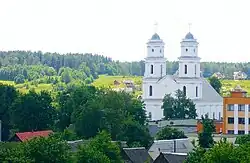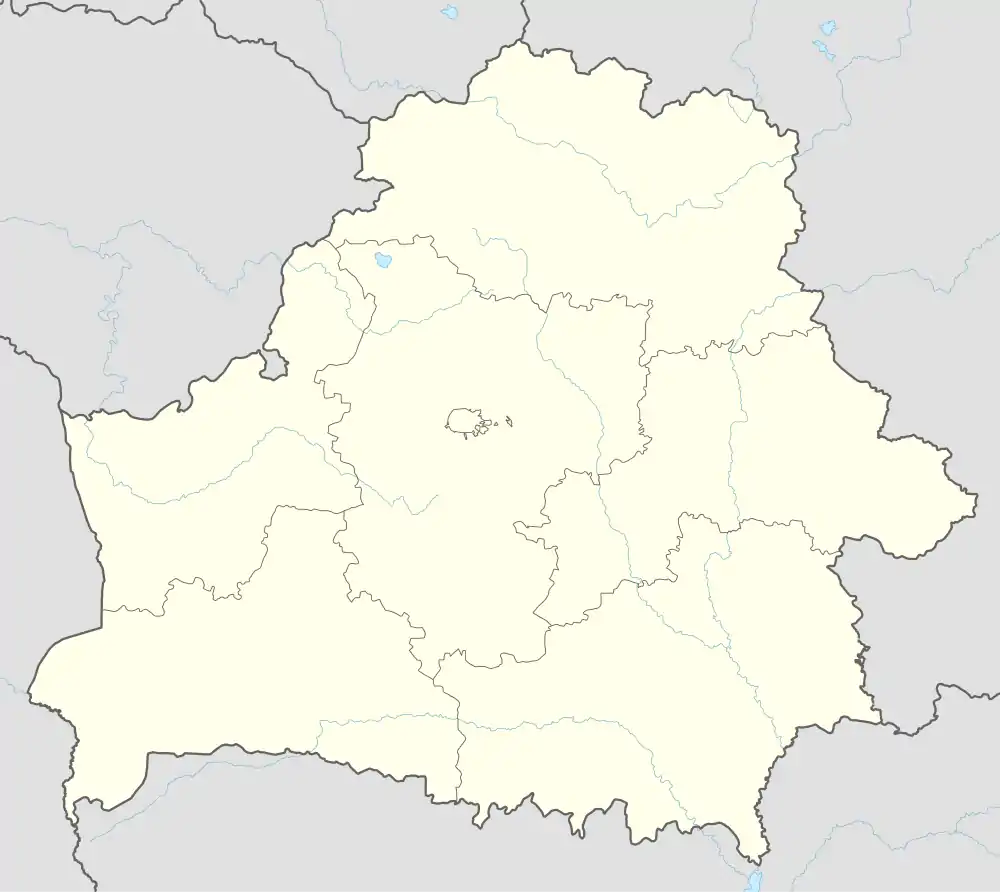Radashkovichy
| |
|---|---|
 | |
 Flag  Coat of arms | |
 Radashkovichy Location of Radashkovichy, shown within Minsk Region | |
| Coordinates: 54°9′N 27°14′E / 54.150°N 27.233°E | |
| Country | Belarus |
| Region | Minsk Region |
| District | Maladzyechna District |
| Population (2023)[1] | |
| • Total | 6,225 |
| Time zone | UTC+3 (MSK) |
Radashkovichy[lower-alpha 1] (Belarusian: Радашковічы, romanized: Radaškovičy;[lower-alpha 2] Russian: Радошковичи, romanized: Radoshkovichi; Polish: Radoszkowicze; Lithuanian: Radaškonys) is an urban-type settlement in Maladzyechna District, Minsk Region, Belarus.[1] As of 2023, it has a population of 6,225.[1]
A watershed of the Vileyka-Minsk water system is located nearby.
History
.jpg.webp)
Radoszkowicze was a royal town, administratively located in the Mińsk County in the Mińsk Voivodeship of the Polish–Lithuanian Commonwealth.[2] In 1708, during the Great Northern War, King Charles XII of Sweden stayed in the town for 11 weeks.[2]
Following the Second Partition of Poland (1793), it was annexed by the Russian Empire, within which it belonged to the Vileysky Uyezd of the Vilna Governorate. In the interbellum, it was part of reborn Poland, within which it was administratively located in the Wilno District 1919–1920, then the Nowogródek Voivodeship in 1921–1922, Wilno Land in 1922–1926, and Wilno Voivodeship afterwards.
Following the joint German-Soviet invasion of Poland, which started World War II in September 1939, the village was occupied by the Soviet Union until 1941, then by Germany until 1944, and re-occupied by the Soviet Union, which annexed it from Poland in 1945. The Germans operated a forced labour camp for Jews in the town.[3]
Coat of arms
On February 23, 1792, the coat of arms was received.
The arms was mentioned in confirmation royal privilege of February 23, 1792. On the arms in a silver background it is represented the stoning of Saint Stephen. In privilege of 1792 the arms is represented in a round shield, there was a version in a baroque shield later. The arms was registered by authorities of Belarus on December 23, 1999.
Demographics
| Year | Pop. | ±% |
|---|---|---|
| 1859 | 1,223 | — |
| 1866 | 1,125 | −8.0% |
| 1897 | 2,615 | +132.4% |
| 1921 | 2,459 | −6.0% |
| 1931 | 2,574 | +4.7% |
| 2023 | 6,225 | +141.8% |
| Sources:[2][4][5][1] | ||
Language
- Language according to the Imperial census of 1897.[4]
| Language | Number | percentage (%) | males | females |
|---|---|---|---|---|
| Jewish | 1 515 | 57.9 | 725 | 790 |
| Polish | 521 | 19.9 | 254 | 276 |
| Belarusian | 500 | 19.1 | 224 | 276 |
| Russian | 76 | 2.9 | 46 | 30 |
| Other | 3 | 0.1 | 2 | 1 |
| Total | 2 615 | 100.0 | 1 251 | 1 364 |
Notes
References
- 1 2 3 4 "Численность населения на 1 января 2023 г. и среднегодовая численность населения за 2022 год по Республике Беларусь в разрезе областей, районов, городов, поселков городского типа". belsat.gov.by. Archived from the original on 17 April 2023. Retrieved 5 October 2023.
- 1 2 3 Słownik geograficzny Królestwa Polskiego i innych krajów słowiańskich, Tom IX (in Polish). Warszawa. 1888. p. 439.
{{cite book}}: CS1 maint: location missing publisher (link) - ↑ "Zwangsarbeitslager für Juden Radaškovicy". Bundesarchiv.de (in German). Retrieved 10 January 2024.
- 1 2 "Vileyka district - the city of Radashkovichy". Demoscope Weekly. Retrieved 10 January 2024.
- ↑ Wiadomości Statystyczne Głównego Urzędu Statystycznego (in Polish). Vol. X. Warszawa: Główny Urząd Statystyczny. 1932. p. 200.